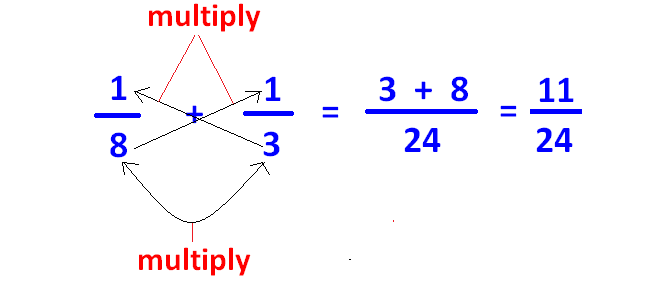ADDING AND SUBTRACTING FRACTIONS
Adding and Subtracting Like Fractions
Fractions which are having the same denominator are called like fractions
Examples :
2/5, 3/5, 4/5
When two or more like fractions are added or subtracted, take the denominator once and combine the numerators.
Example 1 :
Add 1/7 and 3/7.
Solution :
= 1/7 + 3/7
The given fractions are like fractions (having same denominator). To add them, take the denominator once and combine the numerators.
= (1 + 3)/7
= 4/7
Example 2 :
Subtract 2/9 from 5/9.
Solution :
= 5/9 - 2/9
= (5 - 2)/9
= 3/9
= 1/3
Example 3 :
Simplify :
4/5 + 2/5 - 3/5
Solution :
= 4/5 + 2/5 - 3/5
= (4 + 2 - 3)/5
= 3/5
Adding and Subtracting Unlike Fractions
Fractions which are having different denominators are called unlike fractions
Examples :
2/5, 5/7, 2/9, 7/2
To add or subtract two or more unlike fractions, find the least common multiple (LCM) of the denominators. Make the least common multiple as denominator for each fraction using multiplication.
Once the above process is over, all fractions will become like fractions and you can add or subtract them.
Example 4 :
Add 3/4 and 5/6.
Solution :
The given fractions are unlike fractions (having different denominators).
Least common multiple of (4, 6) = 12.
To make the denominator as 12, multiply both numerator and denominator of the first fraction by 3 and the second fraction by 2.
3/4 = (3 x 3)/(4 x 3) = 9/12
5/6 = (5 x 2)/(6 x 2) = 10/12
3/4 + 5/6 :
= 9/12 + 10/12
= (9 + 10)/12
= 19/12
Example 5 :
Subtract 1/9 from 5/6.
Solution :
Least common multiple of (9, 6) = 18.
To make the denominator as 18, multiply both numerator and denominator of the first fraction by 2 and the second fraction by 3.
1/9 = (1 x 2)/(9 x 2) = 2/18
5/6 = (5 x 3)/(6 x 3) = 15/18
5/6 - 1/9 :
= 15/18 - 2/18
= (15 - 2)/18
= 13/18
Example 6 :
Simplify :
3/4 + 1/6 - 5/8
Solution :
Least common multiple of (4, 6, 8) = 24.
To make the denominator as 24, multiply both numerator and denominator of the first fraction by 6, second fraction by 4 and the third fraction by 3.
3/4 = (3 x 6)/(4 x 6) = 18/24
1/6 = (1 x 4)/(6 x 4) = 4/24
5/8 = (5 x 3)/(8 x 3) = 15/24
3/4 + 1/6 - 5/8 :
= 18/24 + 4/24 - 15/24
= (18 + 4 - 15)/24
= 7/24
Cross Multiplication
In adding and subtracting unlike fractions, if the denominators are co-prime or relatively prime, we have to apply this method.
For example, let us consider the addition of two fractions given below.
1/8 + 1/3
In the above two fractions, denominators are 8 and 3.
For 8 and 3, there is no common divisor other than 1.
So 8 and 3 are co-prime.
We can do cross multiplication to add or subtract this kind of fractions as shown below.

Example 7 :
Add 1/2 and 1/3.
Solution :
The given fractions are unlike fractions (having different denominators).
For the denominators 2 and 3, there is no common divisor other than 1.
So, 2 and 3 are co-prime or relatively prime.
We can do cross multiplication to add the given fractions.
= 1/2 + 1/3
= (2 + 3)/(2 x 3)
= 5/6
Example 8 :
Subtract 3/10 from and 5/9.
Solution :
The given fractions are unlike fractions (having different denominators).
For the denominators 10 and 9, there is no common divisor other than 1.
So, 10 and 9 are co-prime or relatively prime.
We can do cross multiplication to add the given fractions.
= 5/9 - 3/10
= (50 - 27)/(9 x 10)
= 23/90
Kindly mail your feedback to v4formath@gmail.com
We always appreciate your feedback.
©All rights reserved. onlinemath4all.com
Recent Articles
-
Multi Step Algebra Word Problems
Apr 23, 24 09:10 PM
Multi Step Algebra Word Problems -
Solving Multi Step Word Problems Worksheet
Apr 23, 24 12:32 PM
Solving Multi Step Word Problems Worksheet -
Solving Multi Step Word Problems
Apr 23, 24 12:07 PM
Solving Multi Step Word Problems
